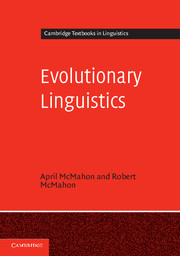
-
Select format
-
- Publisher:
- Cambridge University Press
- Publication date:
- November 2012
- October 2012
- ISBN:
- 9780511989391
- 9780521814508
- 9780521891394
- Dimensions:
- (247 x 174 mm)
- Weight & Pages:
- 0.8kg, 330 Pages
- Dimensions:
- (247 x 174 mm)
- Weight & Pages:
- 0.66kg, 326 Pages
- Subjects:
- Evolution of Language, English Language and Linguistics: General Interest, Language and Linguistics
You may already have access via personal or institutional login- Subjects:
- Evolution of Language, English Language and Linguistics: General Interest, Language and Linguistics
Book description
How did the biological, brain and behavioural structures underlying human language evolve? When, why and where did our ancestors become linguistic animals, and what has happened since? This book provides a clear, comprehensive but lively introduction to these interdisciplinary debates. Written in an approachable style, it cuts through the complex, sometimes contradictory and often obscure technical languages used in the different scientific disciplines involved in the study of linguistic evolution. Assuming no background knowledge in these disciplines, the book outlines the physical and neurological structures underlying language systems, and the limits of our knowledge concerning their evolution. Discussion questions and further reading lists encourage students to explore the primary literature further, and the final chapter demonstrates that while many questions still remain unanswered, there is a growing consensus as to how modern human languages have arisen as systems by the interplay of evolved structures and cultural transmission.
Reviews
‘Ideal material for my postgraduate course in evolutionary linguistics.'
Andrew Smith - University of Stirling
'… this book is an excellent introduction to the origins and development of early human language. It is written in an accessible but authoritative style and will hopefully serve as a rewarding entryway for future scholars interested in this growing subfield of linguistic research.'
Ryan Shosted Source: Journal of Sociolinguistics
Contents
Metrics
Altmetric attention score
Full text views
Full text views help Loading metrics...
Loading metrics...
* Views captured on Cambridge Core between #date#. This data will be updated every 24 hours.
Usage data cannot currently be displayed.
Accessibility standard: Unknown
Why this information is here
This section outlines the accessibility features of this content - including support for screen readers, full keyboard navigation and high-contrast display options. This may not be relevant for you.
Accessibility Information
Accessibility compliance for the PDF of this book is currently unknown and may be updated in the future.


